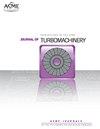Unsteady Flow Interactions Between a High- and Low-Pressure Turbine
IF 3.1
3区 工程技术
Q3 ENGINEERING, MECHANICAL
引用次数: 0
Abstract
This paper presents the unsteady flow interactions between an engine-representative high-pressure turbine (HPT) and low-pressure turbine (LPT) stage, connected by a turbine center frame (TCF) duct with nonturning struts. The setup was tested at the high-speed two-spool test turbine facility at the Institute for Thermal Turbomachinery and Machine Dynamics at Graz University of Technology and includes relevant purge and turbine rotor tip leakage flows. Due to the complexity of such a test, the unsteady component interactions in an HPT–TCF–LPT module have not received much attention in the past and require additional analysis to determine new approaches for further performance improvements on the system level. The flow downstream of an HPT is highly unsteady and dominated by stator–rotor interactions, which affect the flow behavior through the downstream TCF and LPT. To capture the unsteady flow structures, time-resolved aerodynamic measurements were carried out with a fast-response aerodynamic pressure probe (FRAPP) at three different measurement planes. In this paper, the time-resolved and phase-averaged flow fields with respect to the HPT and LPT trigger are studied. Since the two rotors are uncorrelated, the applied method allows the identification of the flow structures induced by either of them. Upstream of the LPT stage, the HPT flow structures evolving through the TCF duct dominate the flow fields. Downstream of the LPT stage, the flow is affected by both the HPT and the LPT secondary flow structures. The interactions between the various stator rows and the two rotors are detected by means of time-space plots and modal decomposition. To describe the fluctuations induced by both rotors, particularly the rotor–rotor interaction, the rotor synchronic averaging (RSA) is used to analyze the flow field downstream of the LPT. This paper highlights the need to account for the HPT-induced unsteady mechanisms in addition to the LPT flow structures and the interaction of both to arrive at improved LPT designs.高压涡轮与低压涡轮之间的非定常流相互作用
本文研究了具有发动机代表性的高压涡轮(HPT)和低压涡轮(LPT)级之间的非定常流动相互作用,它们由带非转向支板的涡轮中心架(TCF)管道连接。该装置在格拉茨工业大学热涡轮机械与机械动力学研究所的高速双轴测试涡轮设备上进行了测试,包括相关的吹扫和涡轮转子尖端泄漏流。由于此类测试的复杂性,HPT-TCF-LPT模块中的非定常组件相互作用在过去没有得到太多关注,需要进行额外的分析,以确定在系统层面进一步改进性能的新方法。高压管道下游的流动是非定常的,且主要受定转子相互作用的影响,从而影响流经下游TCF和LPT的流动行为。为了捕捉非定常流场结构,利用快速响应气动压力探头(FRAPP)在三个不同的测量平面上进行了时间分辨气动测量。本文研究了HPT和LPT触发器的时间分辨流场和相位平均流场。由于两个转子是不相关的,应用的方法可以识别任何一个转子引起的流动结构。在LPT级上游,通过TCF管道演化的HPT流结构主导着流场。在低压段下游,流动同时受到高压段和低压段二次流结构的影响。采用时空图和模态分解的方法检测了各定子排与两个转子之间的相互作用。为了描述两个转子引起的波动,特别是转子-转子相互作用,采用转子同步平均(RSA)方法分析了LPT下游的流场。本文强调,除了LPT流动结构和两者的相互作用外,还需要考虑hpt诱导的非定常机制,以达到改进的LPT设计。
本文章由计算机程序翻译,如有差异,请以英文原文为准。
求助全文
约1分钟内获得全文
求助全文
来源期刊
CiteScore
4.70
自引率
11.80%
发文量
168
审稿时长
9 months
期刊介绍:
The Journal of Turbomachinery publishes archival-quality, peer-reviewed technical papers that advance the state-of-the-art of turbomachinery technology related to gas turbine engines. The broad scope of the subject matter includes the fluid dynamics, heat transfer, and aeromechanics technology associated with the design, analysis, modeling, testing, and performance of turbomachinery. Emphasis is placed on gas-path technologies associated with axial compressors, centrifugal compressors, and turbines.
Topics: Aerodynamic design, analysis, and test of compressor and turbine blading; Compressor stall, surge, and operability issues; Heat transfer phenomena and film cooling design, analysis, and testing in turbines; Aeromechanical instabilities; Computational fluid dynamics (CFD) applied to turbomachinery, boundary layer development, measurement techniques, and cavity and leaking flows.

 求助内容:
求助内容: 应助结果提醒方式:
应助结果提醒方式:


